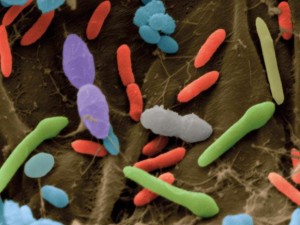I am asking the question here: “how healthy is food from the supermarket?” We tend to assume that food we buy at the supermarket would be safe to eat. Think again, because below I will explain why it is NOT safe.
The “dirty dozen”
You may or may not have heard about the “dirty dozen”. The Environmental Working Group (EWG) is a non-profit organization that monitors fruit and vegetables for insecticide residues. For 2019 they have determined these unhealthy dozen of fruit and vegetables: strawberries, spinach, kale, nectarines, apples, grapes, peaches, cherries, pears, tomatoes, celery, potatoes and peppers (hot and bell peppers). Yes, you counted right, this “dozen” actually consists of 13 items.
When I want to buy any of these fruit, I strictly get fruit and vegetables, which are organic. If this is not available in the regular supermarket, I go to the health food store and buy organic fruit and vegetables there. Local farmers’ markets also offer organically grown produce. Every year the EWG brings out an up-to-date list of the dirty dozen. If an item is not on this list, you can assume that it is safe to eat.
Sugar and too many starches are the next problem
How healthy is food from the supermarket? We said we wanted healthy food. Unfortunately ample consumption of sugar and starchy foods end up as belly fat and also as atheromatous deposits in the arteries. I do not eat bread unless it is 100% rye, but then only 1 or 2 slices occasionally. I do not eat potatoes, rice or pasta. Those who love pasta can eat the pasta-look-alike, called shirataki, which is made from the glucomannan root (also known as konjac root). The carbs here are bound to fiber, which digest a lot slower than regular pasta. So, this means that you are bypassing the section in the supermarket where they sell muffins, donuts etc.
Processed foods
In the center of the supermarket you find all kinds of processed foods. They are usually full of sugar, salt and unhealthy fats (hydrogenated fats). People who eat a lot of processed foods are more prone to get heart attacks, strokes and may even come down with cancer. It is not the kind of food that I want. Instead I like whole foods like organic apples, berries and raw or cooked vegetables.
Fish section
I like salmon, sole, cod, halibut, trout, mussels, shrimp and squid. But I am careful not to load up on the big predator fish like tuna. One has to be careful about methylmercury content in fish. I reviewed fish, mercury contamination and the benefits in this link.
As this link shows, there are low, medium and high methylmercury contaminated fish. The higher the fish is in the predator chain, the higher the methylmercury content. This is of particular concern for pregnant women as mercury is toxic for the fetal brain tissue. But they can consume low mercury fish and shellfish, like mackerel, herring, wild salmon, shrimps or clams. I figure, what’s good for women who are pregnant is good for other people. As a result, I limit my fish meals to the low methylmercury contaminated fish category.
How healthy is food from the supermarket – Meat section
Now your shopping trip becomes problematical. There has been news from the Word Health Organization at the end of 2015 that red meat and red meat products are class 1 carcinogens.
This would mean that you may come down with colorectal cancer, if you consume red meat and red meat products regularly. This is when I stopped eating red meat and red meat products like prosciutto. Unfortunately this warning includes pork, lamb and all sausages as well. In the meantime further research has shown that antibiotics that are fed to beef before they are slaughtered get into the meat and change the human bowel flora when red meat or red meat products are consumed.
Trimethylamine N-oxide (TMAO)
There is a change in bowel flora that causes chemical reactions in the gut with the consumption of beef and eggs. Beef contains carnitine, which can lead to the production of TMAO (trimethylamine N-oxide).
Egg yolk contains choline, which also raises TMAO levels in the blood.
In the following study 113 healthy men and women consumed either a meat diet (beef), white meat diet or protein from non-meat sources. After one month the beef group had triple the amount of TMAO in their blood compared to the other two diets.
Interestingly, when the diets were switched the TMAO levels normalized again in the former beefeaters, when consuming white meat or protein from non-meat sources.
What meat am I shopping for?
I recommend not to eat beef more often than once per week and to eat only grass-fed beef. I eat organic chicken and ground turkey breast meat from health food stores (the turkeys are NOT fed antibiotics). Otherwise I eat seafood, cheese from non-recombinant growth hormone milk. This means that I only buy European import cheese or Canadian cheese. In the US you have to ask for organic milk and organic milk products.
The deep frozen section
I look for deep frozen vegetables, fruit, and fish as well as meats. As vegetables are quickly readied for the freezer, their vitamin content can be higher than that of a vegetable that has spent 8 days in transit from the field to the produce department. The deep frozen section also gives you access to a lot of variety. You’ll be able to enjoy some organic strawberries, even when they are not in season. Read the labels, as some fruit have been packaged with sugar syrup. Look for the varieties, where no sugar has been added. The frozen section also contains some highly processed items: deep-fried foods and dessert selections, which have nothing to do with health, so I avoid them.
Canned foods
Canned foods can be useful, as long as you are dealing with fruit that are canned in their juices and not in sugar syrup. The vegetables are less valuable in vitamins than their deep frozen counterparts. Watch out for varieties, where less salt is added. The label will tell you ”low sodium”. Also pay attention to the cans. Those that are not lined with BPH have a label that emphasizes this. You can avoid this by buying canned food in glass jars, such as tomato sauce.
Cosmetics
You will not have to navigate all the aisles, except for your cleaning products and your cosmetics. These have their own problems: lots of cosmetics contain Parabens. Leave them on the shelf, and be aware that some cleaning products can be hazardous too. Pick environmentally friendly, non-toxic products!
Staples you need
There are some staples, which you will also require: olive oil, some olives, almonds or macadamia nuts (preferably raw). The one cereal product, which is valuable will be coarse rolled oats and some pot barley. Both varieties carry a lot of fibre, which makes them very useful food staples. Avoid the “quick cooking” or “instant” oats. Due to the processing, the carbohydrates are absorbed a lot faster and consequently trigger a higher insulin response.
Drinks
You will wonder about drinks next. Having passed the colas, ginger ales and other sugar pops you may eye the diet drinks. Beware of drinks sweetened with aspartame. There is increasing evidence that phenylalanine (brand names: Aspartame, NutraSweet and Sweet’N Low) is not a “harmless” sweetener. Newer research has shown that it can cause gastroesophageal reflux (=GERD) and migraine headaches. Stevia, a sweetener from a South American plant, does not have harmful effects. Stevia is safe to use, as it does not cause an insulin response. You are best served with mineral water, purified drinking water, herb teas, tea or coffee. Fruit juices do have vitamins and minerals, but they are high in sugar causing an insulin release.
What is in fruit juices?
You would not really eat 3 large apples in one sitting? Probably not! So why insist on drinking 8 oz. of apple juice? You’ll ingest all the sugar and forgo the fibre! You also notice that a lot of fruit juices have been mixed with sugar, water, artificial flavor, some color, and as an apology some vitamin C has been added. They are appearing on the shelves as “a good source of vitamin C”. In reality we are dealing with flavoured, colorful sugar water. Use your own judgement, whether you want to spend your dollars on this selection!
Power bars, snacks
In the aisle adjacent to the pop you will very likely encounter a huge selection of convenience and snack foods. They have several things in common: you have met them on TV, some will be high in starches and fat (chips), others will be high in starches, sugar, and fat (cookies, donuts, cream pastries), and we are dealing with trans fats. Do take time to read the listed ingredients, and then decide, whether you and those who eat in your household deserve nutritional garbage.
Conclusion
We have now completed our round trip in the supermarket. You may still be in mild shock, noticing that “healthy” foods are not the general rule on the shelves. When we buy vegetables and fruit we have to be aware of the “dirty dozen”, which is contaminated with insecticides. We will not buy anything on that list, but buy instead the organic version. You may have to go to the health food store to get these items. Red meat and red meat products produce carcinogens in the human gut. It seems to stem from antibiotics that are used in beef farms and chicken farms. With chicken I buy organic chicken. With beef you need to be more careful and reduce the consumption to once per week and eat only grass-fed beef.
It is tricky to buy healthy food from the supermarket
Much of the bakery section is useless. It consists of empty starch that is digested into sugar and leads to an insulin response. I avoid the processed food section, which contains unhealthy ingredients. Fish is great as long as it does not have too much methylmercury in it. Deep frozen foods may be useful.
Shopping for healthy foods from the supermarket has become more complicated than it was in the past. I only select healthy items and supplement the rest from the health food store. This way I get what I need and avoid the pitfalls of merchandise, which is not beneficial.








